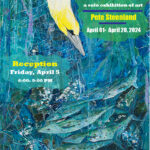By Allison Arteaga
Local Restaurant’s Dressings and Sauces Achieved National Prominence Through Focus On Quality And Tradition
Between rocket launches, fishing, sunbathing, and surfing, the Space Coast is known nationwide for many things. But, oddly enough, the culinary excellence of our many unique family-owned restaurants is not among them. Some would say it’s actually one of our area’s best-kept secrets. But some secrets are just too good not to share. That’s the story behind the success of Makoto’s, a Japanese-style seafood and steakhouse located off Babcock Street in Melbourne.
The family-run restaurant, owned by Melbourne native and entrepreneur Tom Cobb and his family since 1985, is renowned locally not just for its Hibachi-style cooking and generous portion sizes, but also for its delicious fresh sauces and dressings. In fact, products like Makoto’s ginger salad dressing — which combines a salty-sour flavor with notes of fresh vegetables — were so unique that, in the 1990’s, the restaurant began packaging and selling them to local retailers. And by popular demand, they spread rapidly to major grocers across the country, competing with much larger brands to become national best sellers.
“We use fresh ingredients, and that is the whole difference,” said Tom Cobb of the national success of Makoto’s products. “Some companies start with water, put a bunch of powder and oil in there, and out the other end comes dressing, but we’re starting with fresh vegetables. We still make our products much the same way as we did when we bought the restaurant in 1985, when we were making our ginger dressing out the back of our kitchen, five gallons at a time. We’d pour it into an iced tea pitcher and then into the bottle, and we were using hair dryers to heat up the shrink bands in order to get them on the bottles.”
Though Makoto’s fresh-ingredients-first approach hasn’t changed since the beginning, the company did swap out the iced tea pitchers and hair dryers for a state-of-the-art Melbourne factory capable of cranking out 44 bottles per minute for nationwide commercial distribution. Tom’s son David Cobb oversees production, while son-in-law Patrick Greene handles nationwide sales, and David says the factory can fly through 2,000-3,000 pounds of onions, 500-600 pounds of celery, 300 pounds of carrots, and 250 pounds of ginger in a single day. At such break-neck production speeds, making sure Makoto’s sauces and dressings stay true to the flavor they’re famed for can be a challenge. But luckily, the company has a secret weapon for that.
Makoto’s head chef “Yo” Tonyai, originally from Thailand, has been in charge of making Makoto’s signature ginger dressing since shortly after Tom Cobb bought the business in 1985. “I can taste everything in our products and be able to separate out the individual flavors,” Yo says. Over the years, with local restaurant customers serving as guinea pigs, Yo has used his discerning palate and intuitive understanding of flavor to help develop all of Makoto’s most popular dressings and sauces — like the honey ginger dressing, dill dressing, vegetable sauce and seafood sauce — and source ingredients for successful large-scale production that stays true to original taste.
That concept of staying true to roots, whether it’s with taste, talented longtime employees, family ownership, or connection to local markets has always been a big part of the Makoto’s success story. Which is why, even as the company continues to grow and expand into exciting new realms, like private label product lines for major supermarket chains, Makoto’s will stay headquartered right here on the Space Coast. “Obviously I’ve had offers from our competitors and things like that,” Tom Cobb says, “But everyone’s here as a team. Melbourne is home.”
For more about Makoto’s, a Japanese-style seafood and steakhouse, visit MakotosMelbourne.com.
For more about Makoto’s famous ginger salad dressing, visit MakotoDressing.com.
This article appears in the April 2015 issue of SpaceCoast Living.
Did you like what you read here? Subscribe to SpaceCoast Living.













